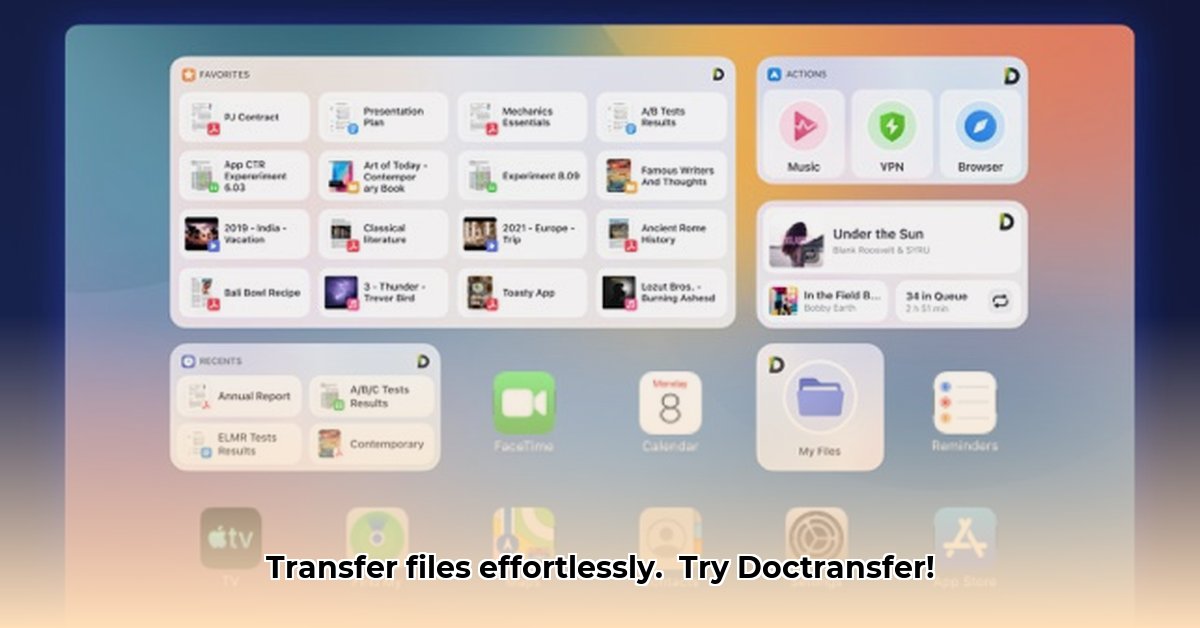
Moving files between devices shouldn't be a complicated process. Whether you're sharing photos with friends, collaborating on a project, or backing up important data, efficient file transfer is crucial. This article compares several popular methods, including Doctransfer, highlighting their strengths and weaknesses to help you choose the best option for your needs. We'll consider speed, security, compatibility, ease of use, and file size limitations.
Comparing File Transfer Methods: A Detailed Analysis
Several methods exist for transferring files, each with its own advantages and disadvantages. Let's examine some of the most common options.
AirDrop
AirDrop is a proprietary Apple technology enabling fast, wireless file transfers between nearby Apple devices (iPhones, iPads, Macs).
Pros: * Speed: Very fast for small to moderately sized files. * Ease of Use: Extremely intuitive and user-friendly. * Security: Relatively secure within the Apple ecosystem.
Cons: * Compatibility: Limited to Apple devices only. * File Size Limits: Performance can degrade with very large files. * Range: Requires close proximity between devices.
Use Cases: Ideal for quickly sharing photos, videos, and small documents between Apple devices within a close range.
Wi-Fi Transfer Apps
Numerous apps facilitate file transfers over a Wi-Fi network, offering broad compatibility across various operating systems (iOS, Android, Windows, macOS).
Pros: * Compatibility: Works across a wide range of devices and operating systems. * Speed: Can be significantly faster than cloud-based methods for large files, especially on a local network. * File Size Limits: Generally handles large files effectively.
Cons: * App Requirement: Requires installing a dedicated app on each device. * Security: Security relies on the app's implementation and the security of your Wi-Fi network. * Setup: Initial setup might require some technical knowledge.
Use Cases: Best for transferring large files or many files between devices using a common Wi-Fi network, regardless of operating system.
Doctransfer
Doctransfer, based on our research, utilizes standard Wi-Fi or USB connections for file transfer. It prioritizes ease of use and simplicity.
Pros: * Ease of Use: Designed for straightforward file transfers. * Simplicity: Minimal setup and configuration required.
Cons: * Speed: Transfer speeds may be moderate compared to dedicated Wi-Fi transfer apps or AirDrop. * Compatibility: May have limited browser compatibility. (Further clarification on supported browsers is needed). * Security: Security depends on the underlying Wi-Fi or USB connection.
Use Cases: Suitable for simple, everyday file transfers where speed is not the critical factor and compatibility across different browsers is not needed. A potential option for users uncomfortable with more technically advanced file transfer methods.
Choosing the Right File Transfer Method: Actionable Insights
Selecting the optimal file transfer method depends on several factors:
Speed: For immediate transfers of large files, Wi-Fi transfer apps or external drives offer the best performance. AirDrop shines for quick transfers between Apple devices. Doctransfer offers moderate speeds suitable for less time-sensitive transfers.
Security: For highly sensitive data, prioritizing encryption is key. External drives and some dedicated Wi-Fi transfer apps offer robust security features. Cloud services also provide options, but carefully review their security policies.
Compatibility: If transferring between different operating systems (e.g., iOS and Windows), Wi-Fi transfer apps provide the broadest compatibility. AirDrop restricts itself to the Apple ecosystem. Doctransfer’s compatibility requires further investigation.
Ease of Use: AirDrop boasts exceptional ease of use within the Apple environment. Doctransfer aims for simplicity. Wi-Fi transfer apps vary in user-friendliness; choosing a well-reviewed app is crucial.
File Size: Large files are best handled by Wi-Fi transfer apps, external drives, or cloud storage services (depending on internet speed and storage costs). Smaller files can be easily transferred using AirDrop, Doctransfer, or even email.
Conclusion: Streamline Your File Transfers
Efficient file transfer is essential in today's digital landscape. The best method depends on your specific needs and priorities. Weigh the trade-offs between speed, security, compatibility, ease of use, and file size limitations when choosing the ideal approach. By carefully considering these factors, you can significantly improve your workflow and streamline your file transfer processes. Understanding the nuances of each method will empower you to choose the right tool for every task.